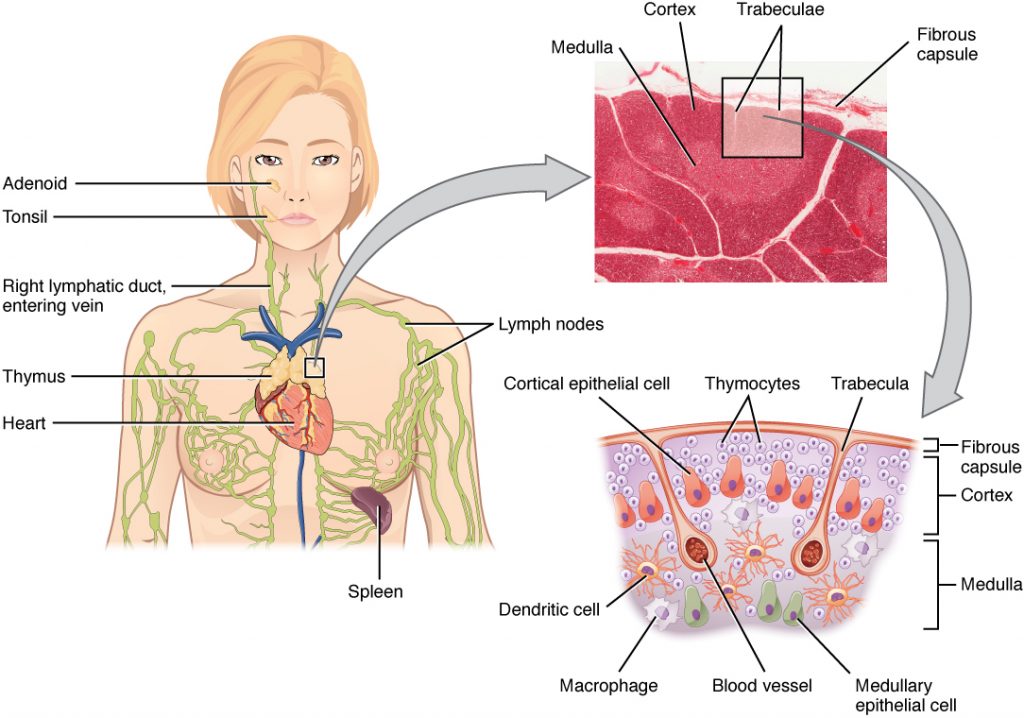11.9 Immune System
See Figure 11.13[1] to review the various structures of the immune system. The immune system provides specific and nonspecific defense mechanisms to protect the body from infection. Examples of a specific defense are white blood cells that circulate in the blood and lymph. The function of these cells is to identify and destroy pathogens such as bacteria and viruses. Examples of nonspecific defenses are the skin and mucous membranes. These parts of the system act as barriers to block entrance of pathogens. For more information, refer to the “Defenses Against Transmission of Infection” section in Chapter 4.

Immune system function and decreasing the risk for infection depends on healthy nutrition. In fact, malnutrition is the leading cause of immune system deficiency worldwide. When immune system functions are inadequate, there is a marked increase in the chance of getting an infection. Children in many poor, developing countries who lack good sources of protein and carbohydrates often die from infections that their bodies would have normally fought off with proper nutritional intake. Because their protein and/or energy intake is so low, the immune system cannot perform its functions.[2]
Other nutrients, such as iron, zinc, selenium, copper, folate, and vitamins A, B6, C, D, and E, benefit immune system function. It is best to obtain minerals and vitamins from eating a variety of healthy foods. Deficiencies in these nutrients can cause an increased risk for infection and even death. Zinc deficiency results in suppression of the immune system’s skin barrier functions and is also associated with a decrease in the number of circulating white blood cells. Taking zinc supplements has been found to be therapeutically beneficial for the treatment of leprosy, tuberculosis, pneumonia, and the common cold.[3]
Just as undernutrition compromises immune system health, so can overnutrition that causes obesity. People who are obese are at increased risk for developing diabetes, cardiovascular, and immune system disorders. High intake of saturated and trans fats negatively affects the immune system, whereas increasing intake of omega-3 fatty acids (found in salmon and other oily fish) reduces the risk of developing certain autoimmune disorders, such as rheumatoid arthritis. Rheumatoid arthritis affects the joints but is more severe in terms of pain and swelling than osteoarthritis. It can begin as early as age 18. Nursing assistant interventions for osteoarthritis also can be used to help manage the discomfort of rheumatoid arthritis.[4]
Autoimmune disorders cause the body to view parts of itself as foreign, mistake those parts as pathogens, and launch an attack against those parts. It can affect certain parts of the body like skin, joints, or a specific organ, or it can affect the entire body. In the digestive system, it can cause food intolerances, celiac disease, or irritable bowel syndrome. Refer to the Chapter 6.2 subsection on “Modified Diets” for management. See Table 11.9 for common chronic conditions and the interventions nursing assistants can provide to assist with immune disorders. Review section Chapter 4.7, “Signs and Symptoms of Infection” for observations related to the immune system that should be reported to the nurse.
Table 11.9 Common Chronic Conditions of the Immune System and Related Interventions
| Diagnosis | Definition | Symptoms to report | Nursing Assistant Interventions |
|---|---|---|---|
| Asthma | Airways become swollen and narrowed in response to an environmental trigger, making it difficult to breathe. Severe asthma attacks can be life-threatening. | Increased shortness of breath during activity or at rest. |
|
| Type 1 Diabetes | The immune system attacks the pancreas and reduces the production of insulin. | Excessive thirst, hunger, or urination; confusion; or hot/dry or cold/clammy skin. |
|
| Leukemia, Lymphoma, and Other Immune System Cancers | Ineffective white blood cells elevate the risk for life-threatening infection. | Fatigue, weakness, or signs and symptoms of infection. |
|
| Human Immunodeficiency Virus (HIV) | The virus attacks white blood cells that identify pathogens in the body, and they are no longer able to fight infection. | Fatigue, weakness, or signs and symptoms of infection. |
|
| Thyroid Disorders | As the thyroid is attacked by the immune system, the regulation of hormones that control metabolism, energy levels, body temperature, heart rate, and appetite are affected. | Increased fatigue or cold intolerance or changes in appetite or mood. |
|
| Multiple Sclerosis (MS) | The immune system attacks the protective sheath around the spinal cord, causing disruption of signals from the brain to body parts. Functioning can vary from day-to-day. | Decreased mobility or cognition. |
|
- “2206_The_Location_Structure_and_Histology_of_the_Thymus.jpg” by OpenStax College is licensed under CC BY 3.0 ↵
- This work is a derivative of Human Nutrition by University of Hawai‘i at Mānoa Food Science and Human Nutrition Program and is licensed under CC BY NC SA 4.0 ↵
- This work is a derivative of Human Nutrition by University of Hawai‘i at Mānoa Food Science and Human Nutrition Program and is licensed under CC BY NC SA 4.0 ↵
- This work is a derivative of Human Nutrition by University of Hawai‘i at Mānoa Food Science and Human Nutrition Program and is licensed under CC BY NC SA 4.0 ↵

